Cancer Patients Receive Faster, Precise Radiotherapy at Good Samaritan Hospital
New TrueBeam™ Linear Accelerator treats cancer faster, deals effectively with tumor motion and improves the patient experience.
Good Samaritan Hospital treats cancer patients using the new TrueBeam Linear Accelerator system, an innovative medical technology that enables a radically different approach to treating cancer with image-guided radiotherapy. Shawn Zimberg, M.D., Medical Director, John Rescigno, M.D., Associate Medical Director, and Raman Kaul, M.D., treating patients using the hospital’s new system for cancers ranging from breast, prostate, head and neck, gastrointestinal, brain, lung and GYN.
Cancer treatments are changing. The TrueBeam™ Linear Accelerator system is the latest advance in radiotherapy technology. Developed from the ground up to deliver powerful cancer treatments with pinpoint accuracy and precision, TrueBeam opens the door to new possibilities for the treatment of challenging cases such as cancers in the lung, breast, abdomen, and head and neck as well as other cancers that are treatable with radiotherapy.
Treatments can be performed with unparalleled ease, precision and speed. In fact, most treatments take just a few minutes a day. As well as allowing for a more comfortable experience for patients with less time on the treatment couch, faster delivery also allows for reduced chances of patient motion during treatment.
TrueBeam was designed with many features that can improve the overall patient experience. With shorter treatment times and quieter operation, TrueBeam provides for a more comfortable environment for patients. Enhanced communication technology enables a constant interaction between the patient and the therapist who operates the equipment. Three closed-circuit television systems enable the therapist to monitor the patient at all times. Music can be played during treatment, helping to increase patient comfort.
TrueBeam is a game-changing leap in innovation in radiotherapy technology.
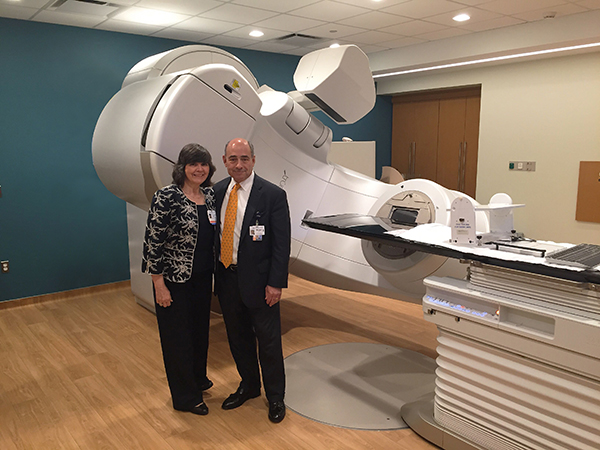
Mary Leahy, M.D., CEO of Bon Secours Charity Health System, with Michael Israel, President and CEO of Westchester Medical Center Health Network
Listen
Listen to John Rescigno, MD, Director of Radiation Oncology at WMCHealth's Good Samaritan Hospital, on WRCR Radio. He describes our multidisciplinary approach to treating cancer closer to home, which includes the most advanced radiation therapies offered. SBRT Radiation Treatment Therapy is now available to treat cancer in approximately two to five treatments, compared to the six- to nine-week timeframe needed for traditional radiation therapy.
The new TrueBeam™ Linear Accelerator system is an advanced radiotherapy technology for treating cancer. Opening up treatment options for people with cancer, it targets tumors with accuracy measured in millimeters. With its power and flexibility, clinicians can develop treatments that are best suited for patients’ individual circumstances.
How Does It Work?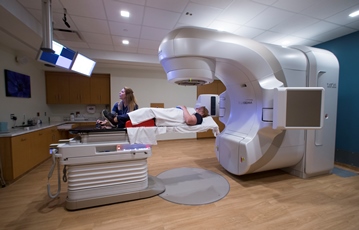
TrueBeam combines imaging, beam delivery and sophisticated motion management to accurately and precisely target tumors with speed.
Quick Facts:
- TrueBeam rotates around the patient to deliver a prescribed radiation dose from nearly any angle.
- An accessory called a multileaf collimator (or MLC) is what shapes the beam. It has 120 computer-controlled “leaves” or “fingers” that create apertures of different shapes and sizes. The leaves sculpt the beam to match the 3-D shape of the tumor. These can move and change during treatment to target the tumor and minimize dose to the surrounding healthy tissue.
- TrueBeam’s additional functionality provides for the acquisition of a cone-beam CT, a form of CT, using 25% less X-ray dose than compared with earlier Varian image-guided technologies. This means patients can be exposed to less X-rays/radiation.
- Real-time imaging tools allow clinicians to “see” the tumor they are about to treat. This gives them confidence, and they can target tumors with accuracy measured in millimeters.
-
The system includes a new “gated” option for synchronizing beam delivery with respiration. This helps maintain accuracy as the system changes its targeting whenever tumor motion is an issue, for example during lung cancer treatments.
- TrueBeam can be used for many forms of advanced treatment techniques including image-guided radiotherapy (IGRT), intensity-modulated radiotherapy (IMRT) and RapidArc® radiotherapy technology. Because of this, patients can receive the treatment that is best suited for their specific clinical circumstances.
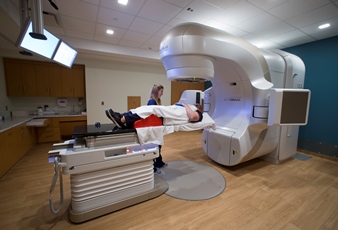
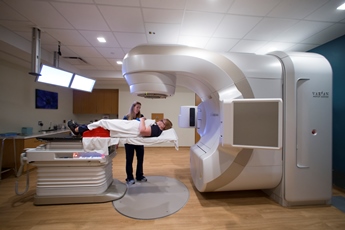
Benefits:
- TrueBeam is a powerful system that opens up treatment options for complex cancers
- TrueBeam is fast and precise
- TrueBeam was developed to address patient comfort
The TrueBeam Linear Accelerator is an advanced radiotherapy system that opens up treatment options for some of the most complex cancers in areas such as the head and neck, lung, breast, abdomen and liver. The TrueBeam system’s advanced imaging and powerful treatment modes allow doctors to tailor treatments specific to your particular cancer.
Treatments with Varian’s TrueBeam are fast. Most can be given within just minutes a day. Treatments that once took 10 to 30 minutes can now be completed in less than two minutes. In addition to enabling a more comfortable experience for the patient with less time on the treatment couch, faster delivery also allows for reduced chances of tumor motion during treatment, which helps protect nearby healthy tissue and critical organs.
Before and at any point during a treatment, the TrueBeam system can generate the three-dimensional images used to fine-tune tumor targeting in much less time (and with less X-rays) than was possible with earlier Varian technologies. These images can be used to fine-tune a patient’s position prior to and during the treatment process.
TrueBeam was also designed to enhance the patient experience. Thanks to an advanced communications system, the therapist running the system can be in constant contact with you. It’s almost as if they are there in the treatment room with you. And as part of this enhancement, TrueBeam has a music feature, which enables music to be played during treatment.
TrueBeam radiotherapy is not appropriate for all cancers. Serious side effects, including fatigue and skin irritation, can occur. Treatment times may vary. Ask your doctor if TrueBeam treatment is right for you.
Hear from Our Patients

Cancer Fighters Team Up — And Win!
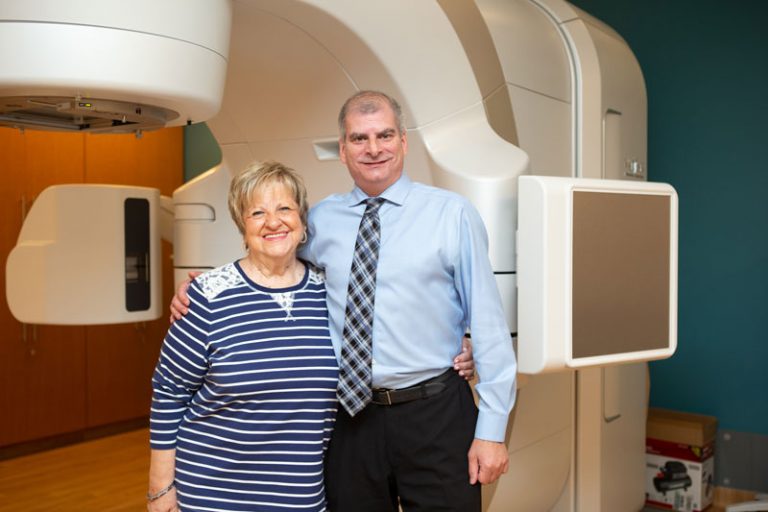
Assisted by powerful technology, the care team at Good Samaritan Hospital helps Carol LaChiana keep singing, laughing and lifting spirits.
By Melissa F. Pheterson
Some disc jockeys begin spinning records as teenagers. Carol LaChiana, on the other hand, was already a grandmother. “My son was asked to DJ a birthday party,” explains the 77-year-old. “But he couldn’t, so I filled in. The next day, my friend gave me a red tambourine and placed an ad in the PennySaver, and I was in business!” Inspired by the soundtrack to her high-school years in Brooklyn, LaChiana specialized in doo-wop parties, traveling to regional party halls from her home in Nanuet.
During treatment for bladder cancer 10 years ago at Good Samaritan Hospital, a member of the Westchester Medical Center Health Network (WMCHealth), LaChiana made known her sense of music and humor. After chemotherapy, when lying down and shaking limbs is recommended, she informed staff: “I’m going home to shake, rattle and roll.” The bladder cancer occurred twice — “playing hide-and-seek with me” — in 2007 and 2008. Once in remission, LaChiana turned her attention to caring for her husband, John, who has Parkinson’s disease.
But in 2017, just after Thanksgiving, LaChiana noticed a lump on her left breast. “Luckily, I had a mammogram the next month.” She returned to Good Samaritan Hospital, where a biopsy confirmed three growths in her breast: two benign, one malignant.
“This was the third time cancer found me,” LaChiana says. “At first I thought: ‘Come on, can you give me a break?’ But I wasn’t going to let it get me down.”
Breast-cancer breakthrough
“Carol’s breast cancer was Stage 1 and responsive to anti-estrogen therapy,” says John Rescigno, MD, Director of Radiation Oncology at Good Samaritan Hospital. “She was a good candidate for what we call breast conservation therapy, which allowed her to avoid a mastectomy by having a small excision, followed by radiotherapy.”
Karen Karsif, MD, Medical Director at Good Samaritan Hospital’s Center for Breast Health, performed the lumpectomy. From there, LaChiana’s care team utilized a new state-of-the-art-machine, known as the TrueBeam Linear Accelerator. At the forefront of cancer-fighting technology, this device delivers powerful and precise radiation through high-energy beams, aimed with accuracy to the millimeter.
Dramatically advanced from traditional radiation, the TrueBeam Linear Accelerator system maps the most direct path to cancer cells in tumors, taking deadly aim at its target while skirting healthy tissue. Since arriving at Good Samaritan Hospital last year, the device has shrunk tumors for hundreds of patients. In LaChiana’s case, it killed any abnormal cells that might have remained in the breast after the surgery.
“Nearly real-time image guidance makes the treatment more precise and accurate,” says Dr. Rescigno. “This allows us to spare healthy tissue, avoid side effects and safely deliver higher doses when needed. In addition, we can decrease the time it takes to treat, which improves patient comfort and outcomes. We are quite privileged to have this technology at our disposal.”
To relieve LaChiana’s anxiety and encourage her humor, the team played 1950s music during treatment. “We laughed together, and it made the treatment less scary,” says LaChiana.
“I call my doctors, nurses and care team my ‘angels,’” she says. “I couldn’t get over the empathy they showed. It’s not always medicine alone that cures a person who is ill. If you have the heartfelt feeling that they care, from the minute the receptionist greets you – it’s half the battle.”
Dr. Rescigno says his team fosters an environment that focuses on patients. “This includes keeping the patients well-informed and comfortable with the decisions they make, and assessing emotional needs, as well. We strive to make this difficult time as pleasant as possible under the circumstances.
“I am very proud of the team we have assembled that collectively has many decades of expertise in radiotherapy,” he adds. “One can have all of the technology in the world, but it is only as good as the people running it.”
High spirits, bright outlook
Throughout her treatment, LaChiana says she drew beauty and strength from patients and families in the waiting room. “You nod at each other and smile, and then you start talking; that’s when you find out there’s someone with prostate cancer, stomach cancer, colon cancer. Everyone is caring for someone else. You forget your troubles for the moment and you say, ‘Wow.’” She was so moved by the people she met and connections she made that she’s writing a short story about her experience.
After most treatment sessions, LaChiana drove to see her husband. “I didn’t want to feel sorry for myself,” she says. “I’m there every day for my husband, John. I sing to families in the nursing home, to women with Alzheimer’s; you can see, they still know the lyrics to songs from their childhood. I make families smile and laugh.”
Her sunny outlook, she knows, begins with herself.
“It’s not funny to have cancer, but I strongly believe I will beat this, that it won’t come back this time,” she says. “I tell myself: ‘Be strong; keep your chins up.’ Yes, I said chins — It’s what happens at my age. And once I know the cancer’s gone, I’ll treat myself to Dunkin’ Donuts.”
Stereotactic Body Radiation Therapy (SBRT)
Overview
Stereotactic body radiation therapy, or SBRT, is a non-invasive cancer treatment that uses advanced image guidance technology to deliver precise, intense doses of radiation to cancer cells. The approach may be used for treating tumors in the prostate, lungs, spine, liver, neck, lymph nodes or other soft tissues.
This advanced radiation therapy allows physicians to treat cancer in approximately two to five treatments, compared to the six- to nine-week timeframe needed for traditional radiation therapy. SBRT's precision accuracy allows oncologists to target and eliminate tumors while preserving healthy surrounding tissue.
SBRT may lead to better outcomes and fewer side effects when compared to conventional radiation therapy. In some cases, SBRT is the only safe technique for delivery of radiation therapy.
How Does SBRT Work?
SBRT uses 3D or 4D imaging and highly focused radiation beams to send high doses of radiation to treatment areas via the Linear Accelerator. These beams of energy are carefully targeted to focus precisely on tumors, which results in minimizing damage to healthy tissues around the area.
Like other forms of radiation therapy, stereotactic body radiotherapy works by damaging the DNA inside the tumor cells, which have inherent defects in DNA repair, unlike normal tissue. As a result, tumor cells die and the tumor shrinks and can be eradicated.
Experienced Radiation Oncologists at Good Samaritan Hospital use a computerized system to shape the radiation beams to match a three-dimensional outline of the tumor. This outline is generated by sophisticated imaging available at Good Samaritan, including CT scan, MRI and PET-CT scanning. Different imaging modalities can be electronically “fused” so that a high level of accuracy is achieved in focusing the beams.
SBRT is performed while the patient is lying on a table and requires no anesthesia. Imaging technology on the Linear Accelerator helps ensure the patient is in the same position for every session and that the target area does not shift during treatment. The patient will be awake during the procedure, which usually takes 15 to 30 minutes.
What Are the Advantages of SBRT?
- Total dose of radiation is divided into larger doses with fewer treatment sessions
- High cumulative dose radiation in five sessions or less
- Daily image guidance
- Robotic positioning with millimeter accuracy
- Real-time motion tracking of patient and tumor
- Patients complete course of treatment much faster than conventional treatment
- Shaves weeks off the traditional duration therapy
- Fewer short- and long-term side effects
- Improved quality of life
What is the Difference Between SBRT and CyberKnife Radiation?
These terms describe the same procedure. CyberKnife is a brand name for one of several available stereotactic radiation devices that deliver radiation with Linear Accelerators. At Good Samaritan Hospital, we use Varian software and hardware to achieve the same benefits.